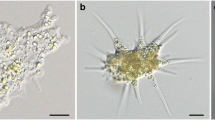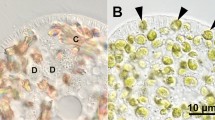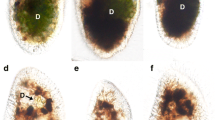Abstract
The ciliate Paramecium bursaria harbors several hundred symbiotic Chlorella spp. cells in the cytoplasm. Algal re-endosymbiosis can be artificially induced using alga-removed P. bursaria. During algal re-endosymbiosis, algae ingested into the host digestive vacuoles (DVs) avoid digestion by the host lysosomal enzymes and then escape into the cytoplasm by budding off of the DV membrane. The budded alga-enclosing DV membrane then differentiates into the symbiosome or perialgal vacuole (PV) membrane and is localized beneath the host cell cortex. In this study, we determined whether the PV membrane has the ability to recognize the symbiotic alga singly by eliminating other small microspheres in the same DV. To clarify the accuracy of the budding process, we mixed fluorescent-labeled microspheres of diameter 0.20 µm with isolated symbiotic algae during algal re-endosymbiosis. No fluorescence was observed from the PV membrane, as expected, and the budding DVs that enclosed both undigested and digested algae. Additionally, the algal re-endosymbiosis rate was significantly reduced in the presence of microspheres. These observations showed that the host P. bursaria allowed budding of the algae singly from the membranes of DVs without microspheres and this process required close contact between the DV membrane and the algal cell wall.





Similar content being viewed by others
Code availability
Not applicable.
References
Albers D, Wiessner W (1985) Nitrogen nutrition of endosymbiotic Chlorella spec. Endocytobio Cell Res 2:55–64
Ahn GS, Choi EY, Jeon KW (1990) A symbiosome-membrane-specific protein in symbiont-bearing Amoeba proteus as studied with a monoclonal antibody. Endocyt Cell Res 7:45–750
Brown JA, Nielsen PJ (1974) Transfer of photosynthetically produced carbohydrate from endosymbiotic Chlorellae to Paramecium bursaria. J Protozool 21:569–570
Cheng YH, Liu CFJ, Yu YH, Jhou YT, Fujishima M, Tsai IJ, Leu JY (2020) Genome plasticity in Paramecium bursaria revealed by population genomics. BMC Biol 18:180. https://doi.org/10.1186/s12915-020-00912-2
Deretic VR, Fratti RA (1999) Mycobacterium tuberculosis phagosome. Mol Microbiol 31:1603–1609
Dryl S (1959) Antigenic transformation in Paramecium aurelia after homologous antiserum treatment during autogamy and conjugation. J Protozool 6:25
Fok AK, Sison BC, Ueno MS, Allen RD (1988) Phagosome formation in Paramecium: effects of solid particles. J Cell Sci 90:517–524
Fitt WK, Trench RK (1983) Endocytosis of the symbiotic dinoflagellate Symbiodinium microadriaticum Freudenthal by endodermal cells of the scyphistomae of Cassiopeia xamachana and resistance of the algae to host digestion. J Cell Sci 64:195–212
Fujishima M, Kodama Y (2012) Endosymbionts in Paramecium. Eur J Protistol 48:124–137. https://doi.org/10.1016/j.ejop.2011.10.002
Fujishima M, Nagahara K, Kojima Y (1990) Changes in morphology, buoyant density and protein composition in differentiation from the reproductive short form to the infectious long form of Holospora obtusa, a macronucleus-specific symbiont of the ciliate Paramecium caudatum. Zool Sci 7:849–860
Griffin FM Jr, Griffin JA, Silverstein SC (1976) Studies on the mechanism of phagocytosis. II. The interaction of macrophages with anti-immunoglobulin IgG-coated bone marrow-derived lymphocytes. J Exp Med 144:788–809
Gu FK, Chen L, Ni B, Zhang X (2002) A comparative study on the electron microscopic enzymo-cytochemistry of Paramecium bursaria from light and dark cultures. Eur J Protistol 38:267–278. https://doi.org/10.1078/0932-4739-00875
He M, Wang J, Fan X, Liu X, Shi W, Huang N, Zhao F, Miao M (2019) Genetic basis for the establishment of endosymbiosis in Paramecium. ISME J 13:1360–1369. https://doi.org/10.1038/s41396-018-0341-4
Hohman TC, McNeil PL, Muscatine L (1982) Phagosome-lysosome fusion inhibited algal symbionts of Hydra viridis. J Cell Biol 94:56–63
Hoshina R, Tsukii Y, Harumoto T, Suzaki T (2021) Characterization of a green Stentor with symbiotic algae growing in an extremely oligotrophic environment and storing large amounts of starch granules in its cytoplasm. Sci Rep 11:2865. https://doi.org/10.1038/s41598-021-82416-9
Iwai S, Fujiwara K, Tamura T (2016) Maintenance of algal endosymbionts in Paramecium bursaria: a simple model based on population dynamics. Environ Microbiol 18:2435–2445. https://doi.org/10.1111/1462-2920.13140
Jimbo M, Yamashita H (2018) Hosts control symbionts using immune system-centered on coral lectin and Symbiodinium. Seibutsukagaku 69:200–208
Johnson MD (2011) The acquisition of phototrophy: adap- tive strategies of hosting endosymbionts and organelles. Photosynth Res 107:117–132. https://doi.org/10.1007/s11120-010-9546-8
Karakashian SJ, Rudzinska MA (1981) Inhibition of lysosomal fusion with symbiont containing vacuoles in Paramecium bursaria. Exp Cell Res 131:387–393
Kodama Y, Fujishima M (2005) Symbiotic Chlorella sp. of the ciliate Paramecium bursaria do not prevent acidification and lysosomal fusion of host digestive vacuoles during infection. Protoplasma 225:191–203. https://doi.org/10.1007/s00709-005-0087-5
Kodama Y, Fujishima M (2007) Infectivity of Chlorella species for the ciliate Paramecium bursaria is not based on sugar residues of their cell wall components, but on their ability to localize beneath the host cell membrane after escaping from the host digestive vacuole in the early infection process. Protoplasma 231:55–63. https://doi.org/10.1007/s00709-006-0241-8
Kodama Y, Fujishima M (2010) Secondary symbiosis between Paramecium and Chlorella cells. Int Rev Cell Mol Biol 279:33–77. https://doi.org/10.1016/S1937-6448(10)79002-X
Kodama Y, Fujishima M (2012) Characteristics of the digestive vacuole membrane of the alga-bearing ciliate Paramecium bursaria. Protist 163:658–670. https://doi.org/10.1016/j.protis.2011.10.004
Kodama Y, Miyazaki S (2021) Autolysis of Chlorella variabilis in starving Paramecium bursaria help the host cell survive against starvation stress. Curr Microbiol 78:558–565. https://doi.org/10.1007/s00284-020-02304-9
Kodama Y, Suzuki H, Dohra H, Sugii M, Kitazume T, Yamaguchi K, Shigenobu S, Fujishima M (2014) Comparison of gene expression of Paramecium bursaria with and without Chlorella variabilis symbionts. BMC Genomics 15:183. https://doi.org/10.1186/1471-2164-15-183
Lin KL, Wang JT, Fang LS (2000) Participation of glycoproteins on zooxanthellal cell walls in the establish- ment of a symbiotic relationship with the sea anemone, Aiptasia pulchella. Zool Stud 39:172–178
Meier R, Lefort-Tran M, Pouphile M, Reisser W, Wiessner W (1984) Comparative freeze-fracture study of perialgal and digestive vacuoles in Paramecium bursaria. J Cell Sci 71:121–140
O’Brien TL (1982) Inhibition of vacuolar membrane fusion by intracellular symbiotic algae Hydra viridis (Florida Strain). J Exp Zool 223:211–218
Reisser W (1976) The metabolic interactions between Paramecium bursaria Ehrbg. and Chlorella spec. in the Paramecium bursaria−symbiosis. I. The nitrogen and the carbon metabolism. Arch Microbiol 107:357–360
Reisser W (1984) The taxonomy of green algae endosymbio- tic in ciliates and a sponge. Br Phycol J 19:309–318
Reisser W (1986) Endosymbiotic associations of freshwater protozoa and algae. In: Corliss JO, Patterson DJ (eds) Progress in protistology, vol 1. Biopress Ltd, Bristol, pp 195–214
Reisser W (1988) Signals in the Paramecium bursaria – Chlorella sp. – association. In: Scannerini S, Smith D, Bonfante-Fasolo P, Gianinazzi-Pearson V (eds) Cell to cell signals in plant, animal and microbial symbiosis. Springe-Verlag, Berlin, pp 281–296
Reisser W (1992) Endosymbiotic associations of algae with freshwater protozoa and invertebrates. In: Reisser W (ed) Algae and symbioses: plants, animals, fungi, viruses, interactions explored, vol 1.1. Biopress, Bristol, pp 1–19
Reisser W, Radunz A, Wiessner W (1982) Participation of algal surface structures in the cell recognition process during infection of aposymbiotic Paramecium bursaria with symbiotic chlorellae. Cytobios 33:39–50
Scholtyseck E, Piekarski G (1965) Electron microscopic studies on merozoites of Eimeria (Eimeria perforans and E. stidae) and Toxoplasma gondii, On the systematic position of T. gondii. Z Parasitenk 26:91–115
Siegel R, Karakashian S (1959) Dissociation and restoration of endocellular symbiosis in Paramecium bursaria. Anat Rec 134:639
Sinai AP, Joiner KA (1997) Safe haven: the cell biology of nonfusogenic pathogen vacuoles. Annu Rev Microbiol 51:415–462
Song C, Murata K, Suzaki T (2017) Intracellular symbiosis of algae with possible involvement of mitochondrial dynamics. Sci Rep 7:1221. https://doi.org/10.1038/s41598-017-01331-0
Stoecker DK, Johnson MD, de Vargas C, Not F (2009) Acquired phototrophy in aquatic protists. Aquat Microb Ecol 57:279–310. https://doi.org/10.3354/ame01340
Tsukii Y, Harumoto T, Yazaki K (1995) Evidence for a viral macronuclear endosymbiont in Paramecium caudatum. J Euk Microbiol 42:109–115
Wood-Charlson ME, Hollingsworth LL, Kruoo DA, Weis VM (2006) Lectin/glycan interactions play a role in recognition in a coral/dinoflagellate symbiosis. Cell Microbiol 8:1985–1993. https://doi.org/10.1111/j.1462-5822.2006.00765.x
Weis DS (1984) The effect of accumulation time of separate cultivation on the frequency of infection of aposymbiotic ciliates by symbiotic algae in Paramecium bursaria. J Protozool 31:14A
Wiejak J, Surmacz L, Wyroba E (2003) Dynamin involvement in Paramecium phagocytosis. Europ J Protistol 39:416–422. https://doi.org/10.1078/0932-4739-00014
Acknowledgements
P. bursaria strains were provided by the National BioResource Project Paramecium (Yamaguchi University, Japan). We would also like to thank Editage (www.editage.jp) for English language editing.
Funding
This work was supported by a Grant-in-Aid for Scientific Research (C) (Grant numbers 17K07513 and 20K06768) from the Japan Society for the Promotion of Science (JSPS) and the Institute for Fermentation (IFO; Osaka, Japan) to Y.K. The authors thank the faculty of Life and Environmental Sciences in Shimane University for the financial support in publishing this report.
Author information
Authors and Affiliations
Contributions
Yuuki Kodama and Haruka Sumita conceived, designed, and performed the experiments. Yuuki Kodama wrote the manuscript.
Corresponding author
Ethics declarations
Ethics approval
Not applicable.
Consent to participate
Not applicable.
Consent for publication
Not applicable.
Conflict of interest
The authors declare no competing interests.
Additional information
Handling Editor: Ralph Gräf
Publisher’s note
Springer Nature remains neutral with regard to jurisdictional claims in published maps and institutional affiliations.
Rights and permissions
About this article
Cite this article
Kodama, Y., Sumita, H. The ciliate Paramecium bursaria allows budding of symbiotic Chlorella variabilis cells singly from the digestive vacuole membrane into the cytoplasm during algal reinfection. Protoplasma 259, 117–125 (2022). https://doi.org/10.1007/s00709-021-01645-x
Received:
Accepted:
Published:
Issue Date:
DOI: https://doi.org/10.1007/s00709-021-01645-x




